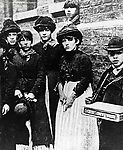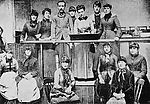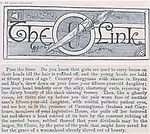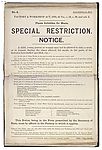 Match workers at the Bryant and May factory 1888
Match workers at the Bryant and May factory 1888 The Matchworkers' Strike Committee 1888
The Matchworkers' Strike Committee 1888 To the Shareholders of Bryant & May
To the Shareholders of Bryant & May  Slaved out of Beauty
Slaved out of Beauty Another case of Phossy Jaw - 1898
Another case of Phossy Jaw - 1898 Restriction Notice - Factory & Workshops Act 1878
Restriction Notice - Factory & Workshops Act 1878

June 1888 the Fabian Society met in London to hear a speech on female labour. Annie Besant, a writer and campaigner, was in the audience, and was horrified to hear of the conditions facing the workers at the Bryant and May match factory. The following day she waited at the factory gates and spoke to some of the women as they left. On 23rd June she published an article, "White Slavery in London", in her newspaper, "The Link". Bryant and May reacted angrily to the article, and tried to force the workers to sign a statement denying Besant’s claims. When workers refused to sign, the ringleaders were sacked. 200 women immediately went on strike, and headed straight to the offices of "The Link" to gain Besant’s support and advice. The word soon spread and 1,400 workers came out in sympathy.
The conditions that Besant had exposed were appalling. The girls, some as young as 13, as can be seen from the photograph, worked 14 hour days for as little as 5 shillings (equivalent today to approximately £19) a week. They were subjected to fines for talking, going to the toilet, dropping matches and being late. This was a standard fine of half a day’s pay, regardless of the time they arrived at work. Some workers were charged for some of the materials that they needed to produce the matches. They also complained that all workers had been forced to “donate” money to a statue of Gladstone in 1882, by having a shilling deducted by Bryants from their wages.
The health risks from carrying heavy boxes, and exposure to white phosphorous, meant that many girls often became very ill and disfigured, and eventually died very painful, early deaths. Heavy boxes were carried on the heads of girls leading to dramatic hair loss. A copy of Besant’s account from "The Link" has been reproduced here for you to read. (See “Slaved out of Beauty”, or read the whole article, "To the Directors of Bryant & May".)
The exposure to white phosphorous led to yellowing skin, hair loss, and a condition called "phossy jaw". Starting with tooth ache and facial swelling, the condition developed into abscesses of the jaw bone, which were extremely painful, unsightly and repellent, as drainage from the dying bone tissue was exceedingly foul-smelling. The jawbones would gradually rot away, and would actually glow a greenish-white colour in the dark. Removal of the jaw bones might save the sufferer's life, otherwise it could cause serious brain damage or death from organ failure. White phosphorous had already been banned in other countries. The British government felt a ban would restrict free trade. The use of white phosphorous for matches was eventually banned in Britain in 1910. (See "A case of Phossy Jaw 1898".)
The strike by the Matchgirls gained support from a number of public figures, The London Trades Council, the Salvation Army and socialist sympathisers. The women decided to form a Matchgirls' Union and elected Besant the leader. She is standing third from the right in the photograph above. A boycott of Bryant and May’s matches was called for in "The Link," the "Pall Mall Gazette" and the "Labour Elector". The "Times" and other newspapers sympathized with Bryant and May, and blamed Besant and others for the dispute, accusing them of giving bad advice, misleading the girls and encouraging them to strike, and of talking “twaddle”.
Bryant and May threatened legal action against Besant, but no action was taken. The strikers were told that, “the directors will either remove their business to Sweden, where there are several large factories for sale, and where timber is cheaper, or they will secure sufficient workers from Glasgow.” The Social Democratic Federation in Glasgow was contacted and asked to demonstrate against this. A strike fund was organized and distributed amongst the strikers. Many marches and rallies were organized. Public sympathy was raised, when people saw the physical state of the women, and their determination to help themselves. Many of the matchgirls refused to carry collection boxes, stating “Poor as we are, we ain’t come to cadging yet.” 50 women went to Parliament, led by Besant, and spoke with a group of MPs about the issues.
On July 21st 1888, Bryant & May offered proposals to end the strike. All of the complaints were addressed. The women were offered; (1) abolition of fines, (2) abolition of deductions for paint, brushes and stamps, (3) rackers-out to be paid piece work, (4) the packers to have their threepence, (5) all grievances to be taken straight to the managing directors, without the intervention of the foremen. Bryant & May also said that they would, as soon as possible, provide a breakfast-room for the girls, so they would not be obliged to get their meals in the room where they worked. Eating at the work bench was recognised as worsening the exposure to, inhalation and ingestion of phosphorous. The restriction notice above shows that Bryant and May had ignored the Factory and Workshops Act regarding this, for some years. It was agreed that the girls should continue the Union, as Bryant and May recognised the benefit to both parties.
The Matchgirls' Union had, by the end of the year, become the Matchmakers' Union, open to both men and women. Though it only continued until 1903, it is seen as being one of the most important early unions as it showed other “unskilled” workers that they too could organize themselves and stand up for their rights.
Rollover the captions in the box to see the available images in thumbnail format, click the caption to see the full-size image
| Reference: | 696 |
| Keywords: | |
| Archive Ref: | |
| Updated: | Thu 15 May 2008 - 1 |
| Interpretation written by | Jenny Ermoyenous |
| Author's organisation | Curatorial |
| Organisation's website | |
| Source | All images TUC - permission required |